The customer experience is becoming more and more critical for companies wanting to foster a positive and lasting relationship with their customers. Building an efficient, fast, and agile process that solves problems is the challenge of the customer service teams — and it is essential for your company’s strategy.
Considering that acquiring new customers is much more costly than retaining current ones, it is crucial to have a well-structured support team with the required tools to achieve customer satisfaction in any scenario. In this article, you will learn which steps are essential for a successful customer support process and how to structure them in Pipefy.
1. Customer Satisfaction: vital to your success
Companies of different sizes that offer a product or service should be concerned with their CSAT (Customer Satisfaction Score), which is nothing more than a metric to evaluate customer satisfaction.
Good customer service is one of the main reasons a company’s reputation can be enhanced or destroyed through negative experiences. In many businesses, customer experience is just as essential as the product or service itself.
The ideal Customer Service department responds to customer needs with speed and clarity, assisting at different stages: before and after closing. Be mindful that there’s a difference between customer service and customer support (despite being used interchangeably):
1 - Customer Service: assists customers in getting the best value out of a product/service
2 - Customer Support: assists with technical problem solving and troubleshooting
Customer service, as a whole, is an umbrella term that covers different areas and processes (which also includes customer success) and aims to maintain a high and stable NPS (the metric of how likely your customers are to recommend your product or service to other people).
2. Customer Service Challenges
Customer service is strategic — and much more productive, organized, and efficient than we may first imagine. Support teams rush to assist customers, resolve queries, and provide answers as quickly as possible. A structured process is essential to eliminate any obstacles that may impede these goals. Some of the most common challenges customer support faces includes:
Low CSAT: Slow responses, low-resolution speed, and extended deadlines make customers feel undervalued or even ignored, which causes churn.
High cost: Inefficient processes, manual tools, and poorly integrated systems make the process much more costly. The service team wastes time navigating systems and looking for decentralized information.
Lack of metrics visibility: Without clear, well-established, and easy-to-track metrics, it’s difficult to optimize any process — and customer support is no different. Without measuring the quality of support, you are in the dark and unsure of what to improve.
To get rid of these obstacles for good and raise your CSAT to the next level, you need to identify gaps, bottlenecks, and chaotic steps. Perhaps you haven’t structured your process in the best way, which is why we’re going to take a closer look at each phase of the customer support process.
3. The Customer Support Process
Customer support involves multiple steps and points of contact with customers, plus communication among your own team — regardless of the size of your company. Therefore, it’s important to structure well-defined and standardized steps with automation and integrations between different systems.
In the Pipefy Template Gallery, you can find process templates to use as a starting point for further customization. Here is an example of a customer support flowchart:
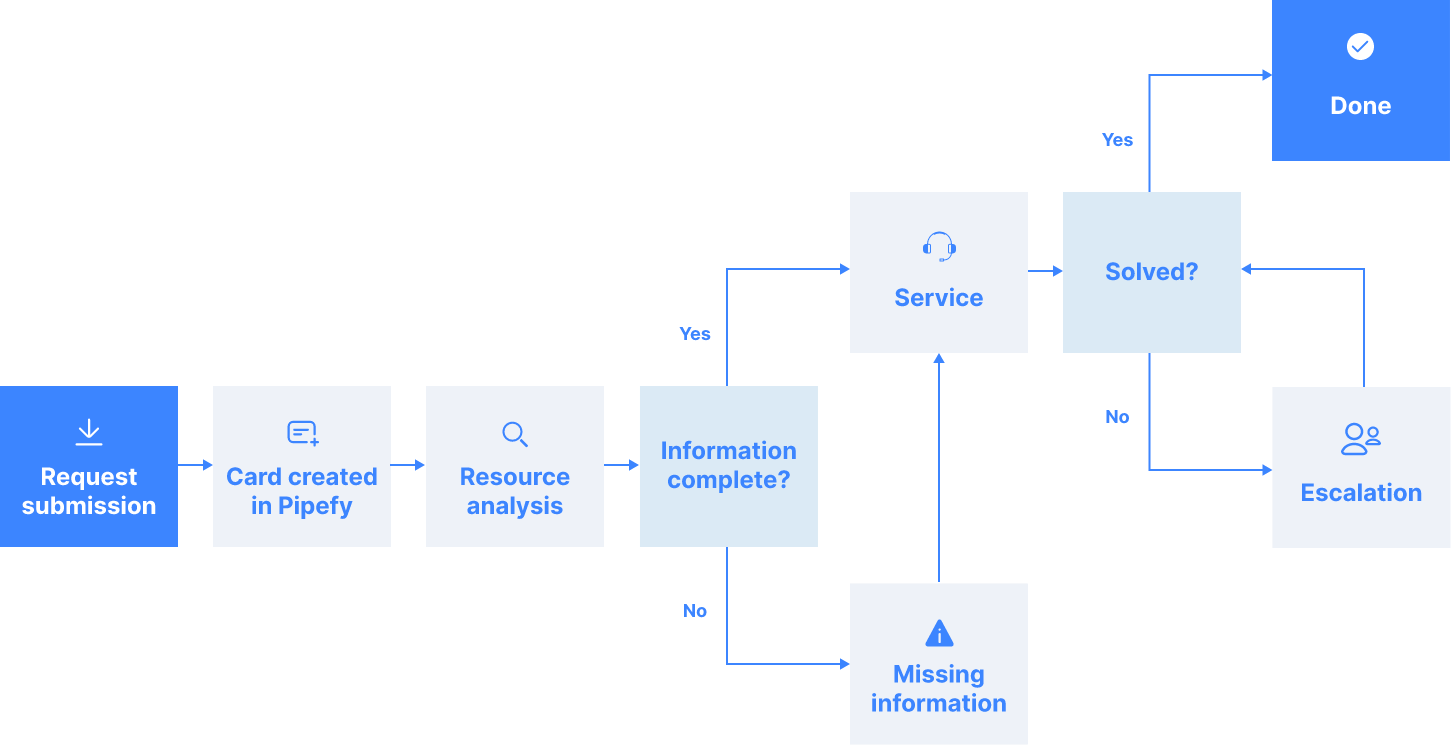
Remember, this is a simplified version of how a customer support process can be built inside Pipefy. Adding complexity is easy and it all depends on your needs and your processes. Let’s check out each phase, and learn how to face common challenges your Customer Support department likely faces!
Step 1: Receiving service tickets
Customers can send requests to the support team through various channels, such as emails, chats, forms, phone calls, etc. These demands can be product questions, defect reports, or general complaints.
Depending on your business type, requests can build up fast, and managing order volume becomes a bottleneck. This is why it’s better to use a dedicated system for managing tickets, so you have all the information centralized and integrated into a single software (no more spread emails and confusing spreadsheets).
By collecting requests in a single place, your analysts won’t need to search multiple sources for data related to the customer demand. Dedicated systems also allow you to integrate and automate your process flow, boosting ticket resolution rate and lead time.
“We would get requests through a wide variety of communication channels. It led to a lot of duplication and complexity in tracking support requests.”
In Pipefy, requests come to the support team in a variety of ways, with the public form being one of the most common paths. You can customize this form however you like with different field types, with complete freedom to include the fields that make sense for your unique situation — such as mandatory and conditional fields (which adapt according to the customer’s responses). Here’s just some examples:
1 - Requester’s Name
2 - Requester’s Email
3 - Request Type
4 - General Details
5 - Attachments
You can add even more fields to create a form that meets your needs. For example, in the Request Type field, you can set a dropdown list with a box for complaints, suggestions, etc. It is important to create a clear form to ensure you collect all the necessary data to complete a ticket without missing information.
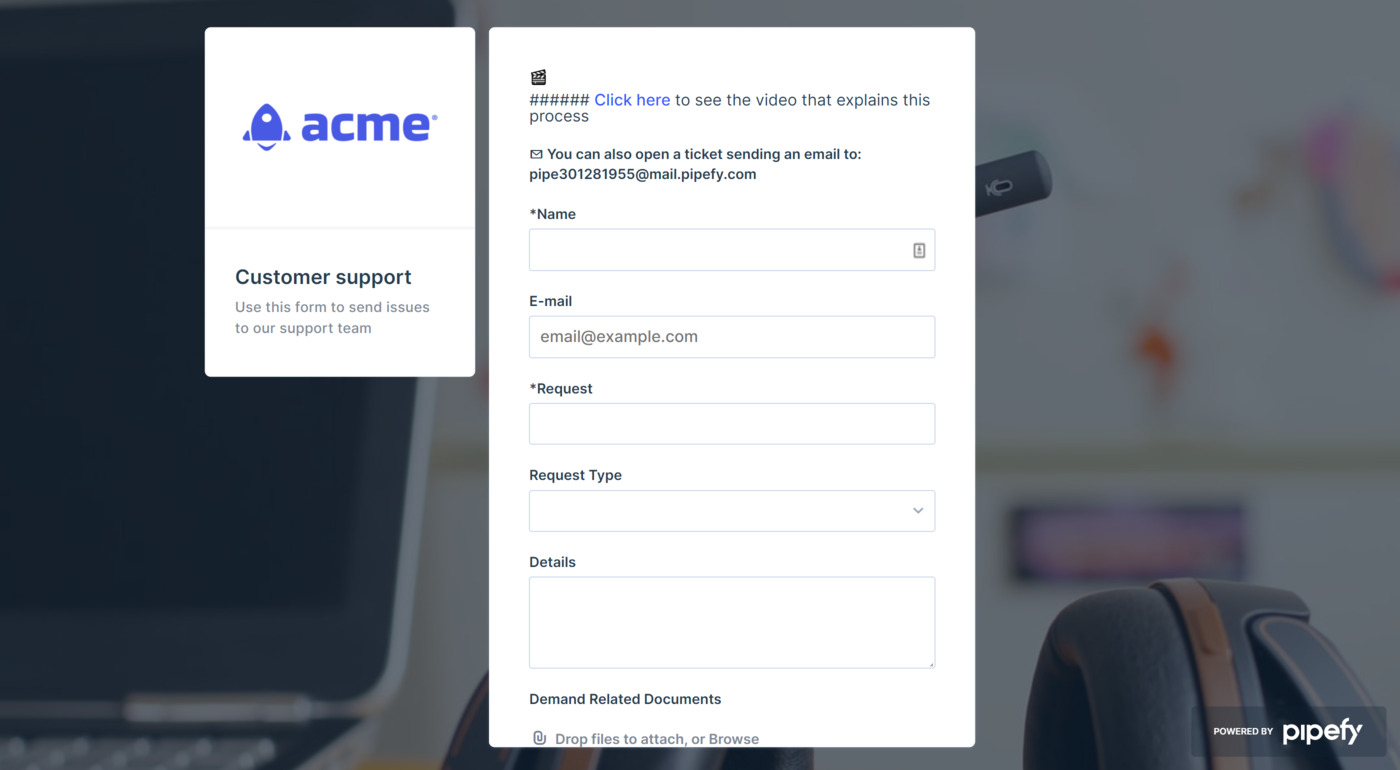
Portal: a page for direct contact with your customers
Public forms have a link that can be shared with any customer without logging in to make the request. You can embed this link on your website if you want, or use a portal, which is a page created by Pipefy that brings different forms together in the same place.
For example, when creating a customer support portal, you can add forms related to the department and make them available on the company’s website as well. This way, forms for the customer support and customer feedback processes can be accessed by requesters through the same URL.
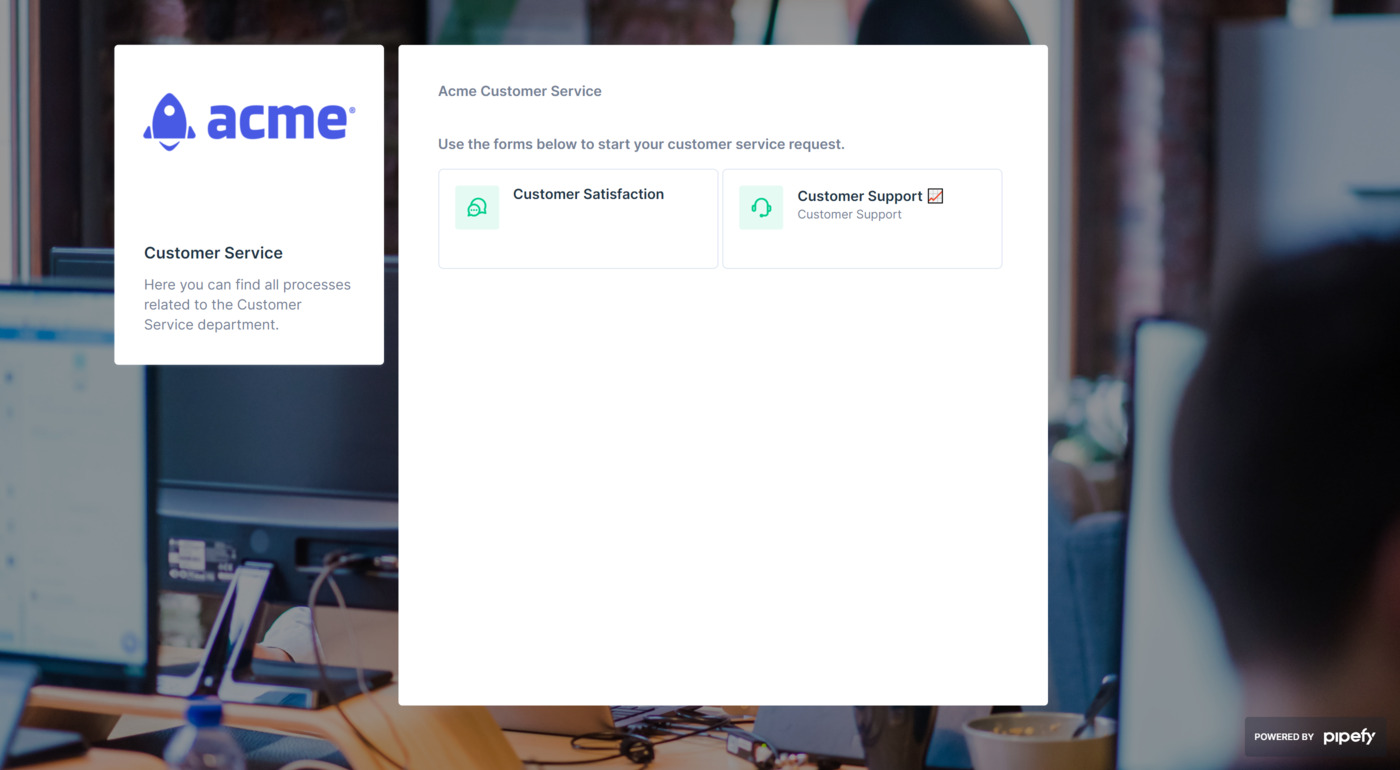
Email: requests arriving through Pipefy
You can receive requests via email, which will also arrive in Pipefy through the public form and portal. To do so, just configure your support inbox within Pipefy and enable the feature to start using the email features.
This way, customers are free to submit their tickets as they prefer, and you will have all your tickets centralized in one place: your workflow in Pipefy. All support analysts can access this email box, so everyone has visibility of the team’s tickets.
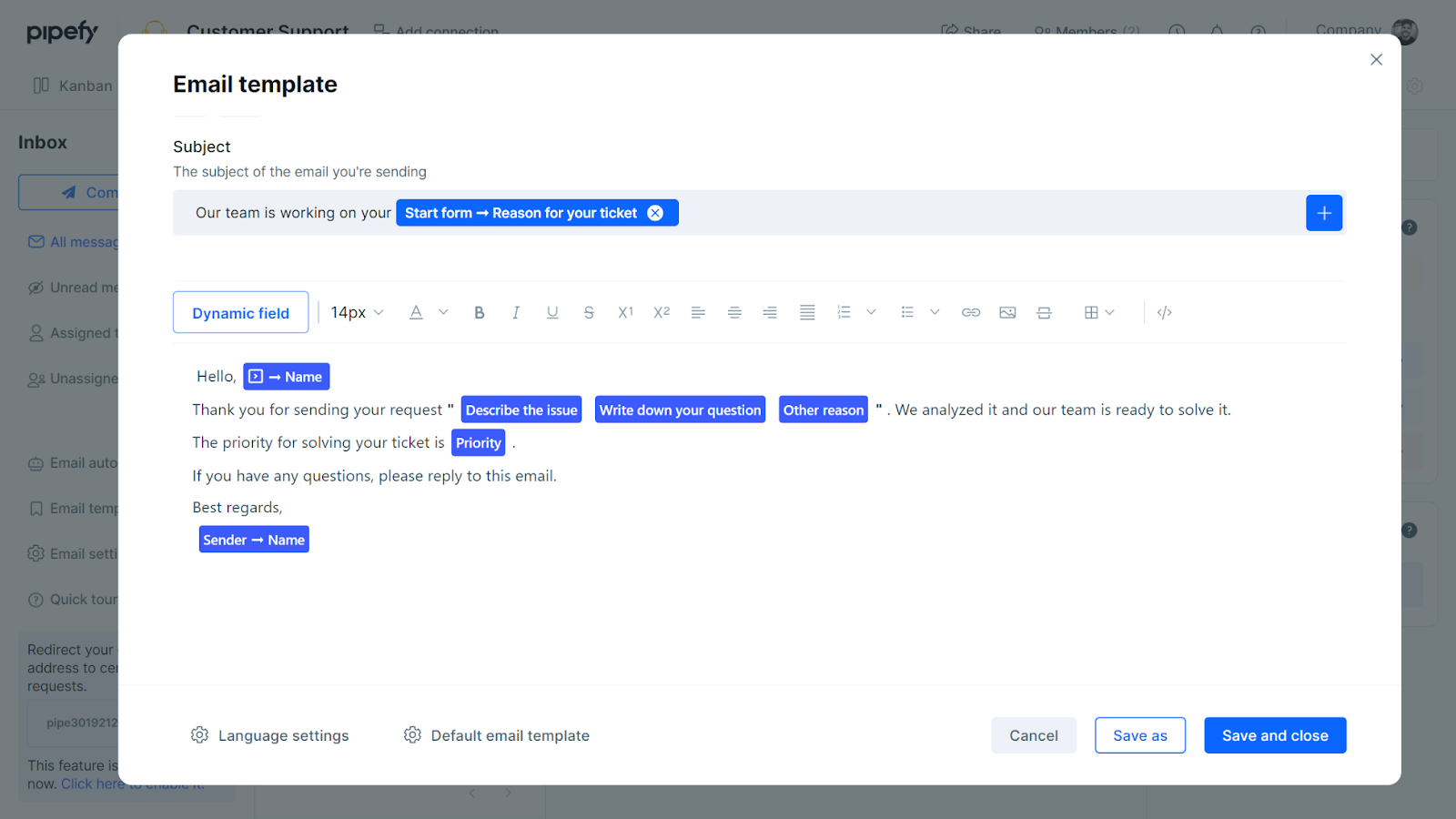
Step 2: Screening
The screening phase is when requests are assigned to team members according to the ticket type. The most common support levels include:
Level 1: They are responsible for solving questions in the first contact or redirecting the query to technical analysts with more specific knowledge.
Level 2: With greater technical knowledge, they step in when the level-one analysts cannot solve the ticket due to its difficulty.
Level 3: Focused on complex problems, this is the most specialized team in the technical area to solve any question related to the product or service.
In the screening phase, it’s time to define deadlines for resolution and the urgency of each ticket. Analysts can write more details after reading the customer’s request. It’s important to always check for requests since you don’t want tickets to be lost or deadlines to get tight before analysts even start the job.
Cards: detailed and standardized tickets for you
When a request is submitted to Pipefy, it is transformed into a card that contains all that ticket’s information. Inside the card, details such as type of request, support team comments, customer communications, deadlines, labels, and much more are centralized.
Cards fall into a workflow with either list or kanban view (columns representing the phases of the process) and can be moved by analysts as they progress through the process. Filters make it easy to find tickets and not lose sight of requests.
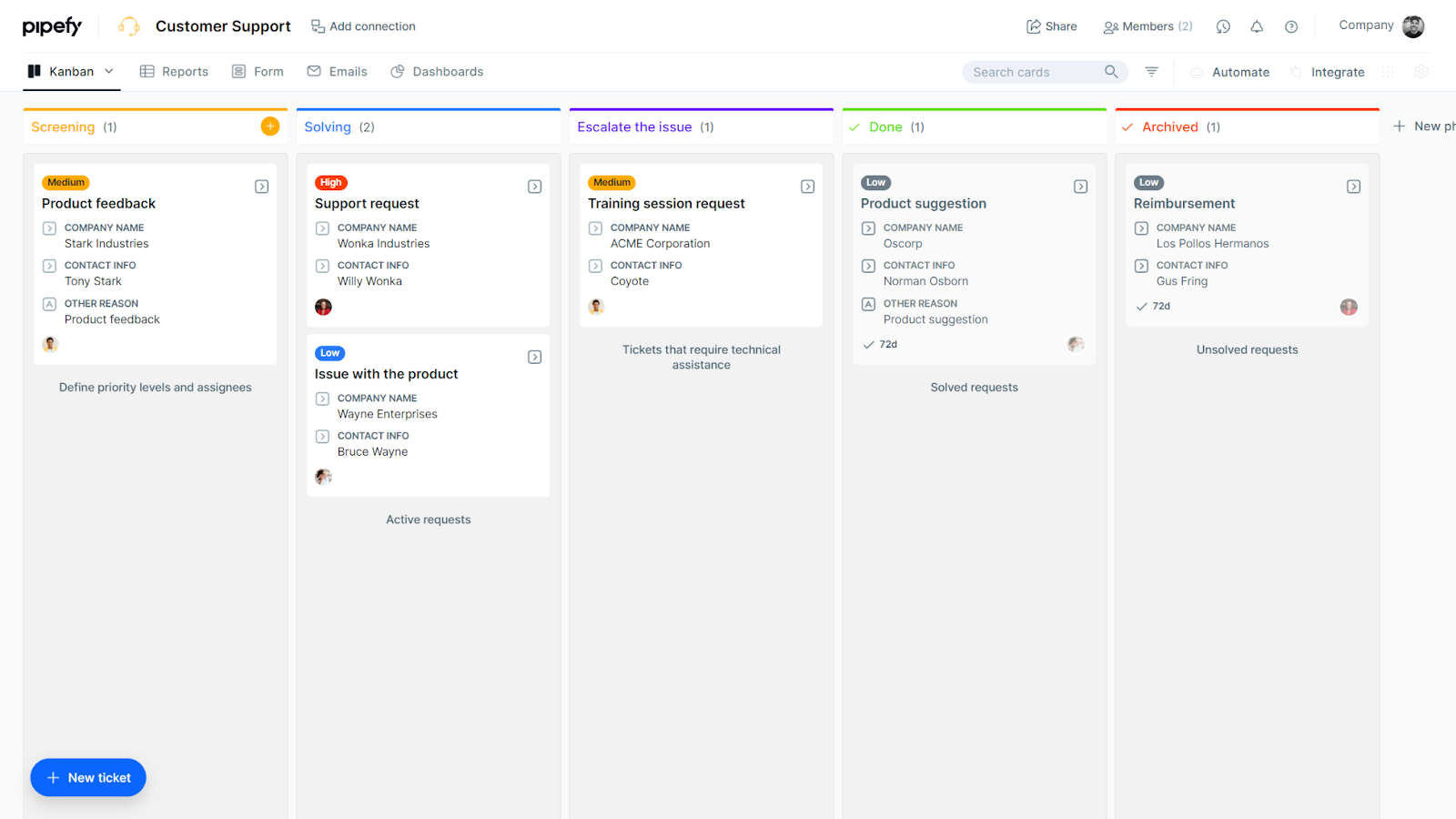
Automations: speed up designating analysts
It is possible to configure different automations in Pipefy to streamline the process, eliminate manual work, and create an error-proof flow. For example, depending on the type of request, you can set rules so specific team members are automatically assigned and notified to check the request.
This is specifically useful to save time analyzing tickets and ensure technical analysts act quickly on complex tickets, shortening the lead time of the operation.
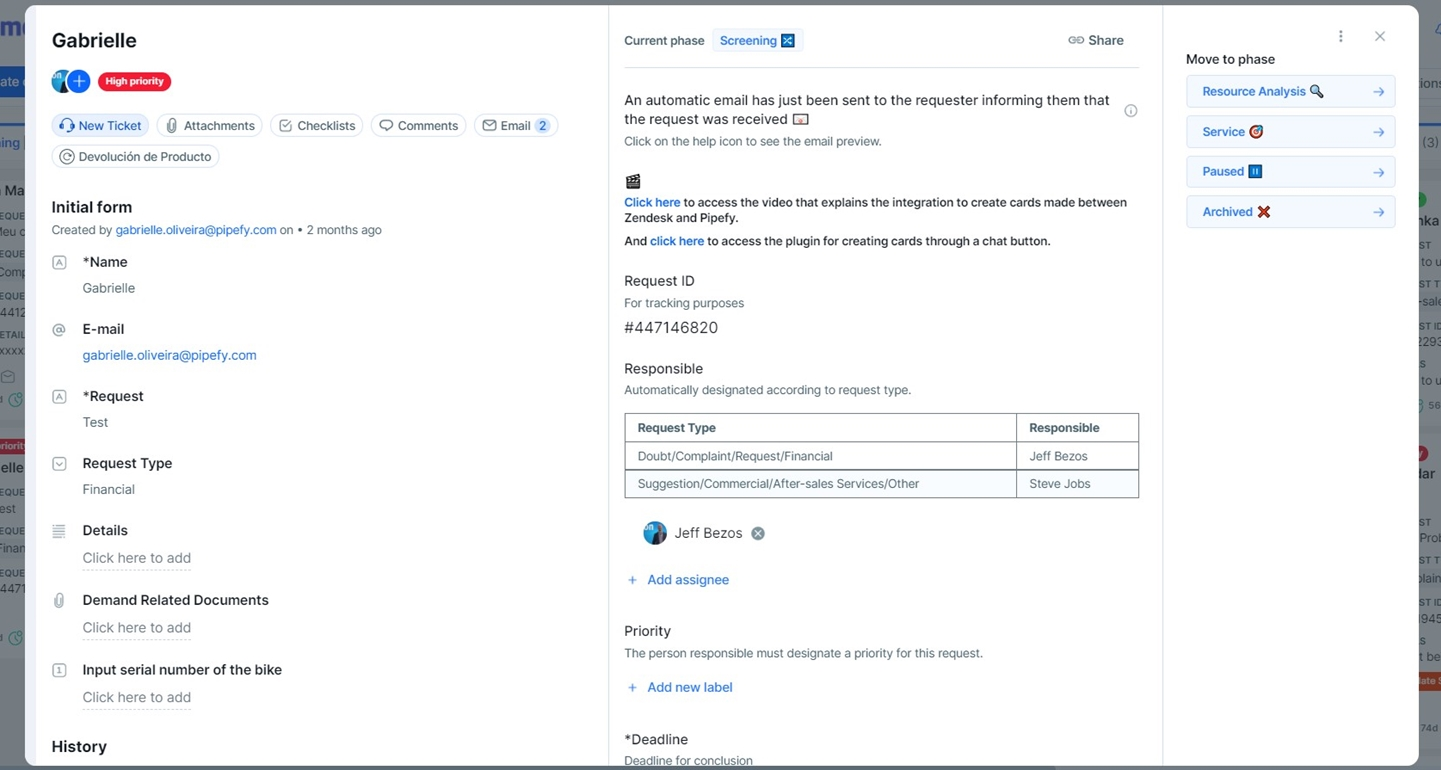
Integrations: other ways to receive tickets in Pipefy
In addition to emails and forms, you can receive support tickets in Pipefy through integrations. It is possible to use a platform such as Zendesk, Intercom, Drift, or others to receive tickets and then manage requests within Pipefy, where data can be integrated and shared with other teams easily.
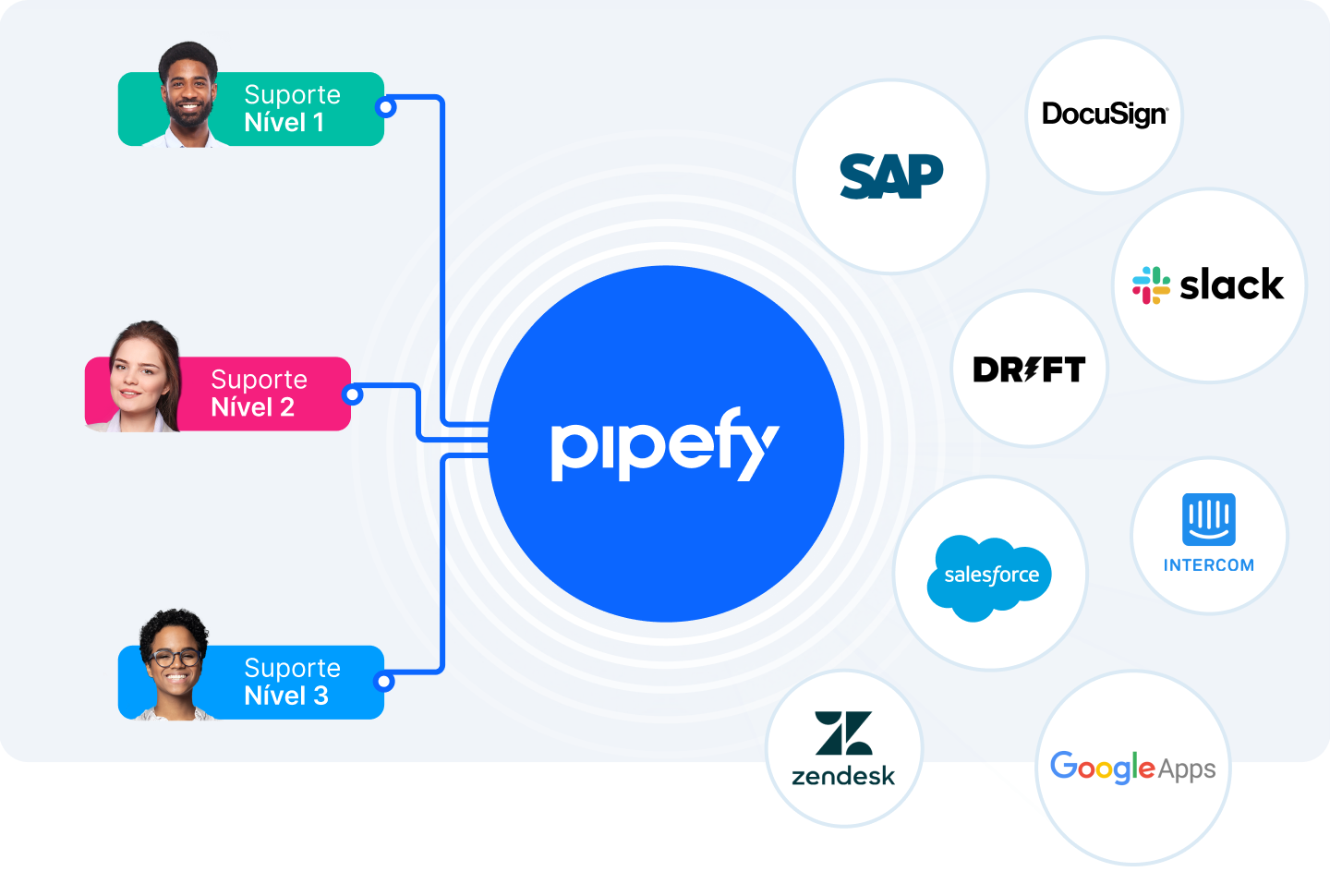
Step 3: Resource analysis and missing information
After selecting the right person to work on a ticket, it is time to analyze the request thoroughly. An analyst looks for any missing information to proceed. If there is, they need to contact the customer. If the problem described by the customer is more complex than reported, the analyst can redirect to a member from the level two or three support.
This is why it’s so important that the information input into the process (whether originated emails, forms, or integrations) is complete. With forms, you have greater security, since you can set mandatory fields that the requester must fill in.
Email templates: automatic and fast communication
You can set email template automations at different phases of your process — for example, sending an email when a request is received or when there is missing information. Email templates have dynamic fields, which are automatically filled in according to card details (such as name, request type, etc.). Thus, you save time and don’t have to compose each email individually.
Phase forms: information submitted and updated
You can also receive information from customers throughout the process —for example, when you need a new input in the missing information phase. To do so, simply configure a phase form, which is nothing more than a public form enabled for a specific phase of your customer support flow. This way, you can send a link to the customer, and they can attach the documents they forgot or write more details for the ticket.
Request tracker: process follow-up
If desired, you can enable the request tracker feature in Pipefy. This means your customers can track which phase their requests are in the Pipefy workflow. Don’t worry, they can’t see what data the team has access to, but they can communicate via comments if needed.
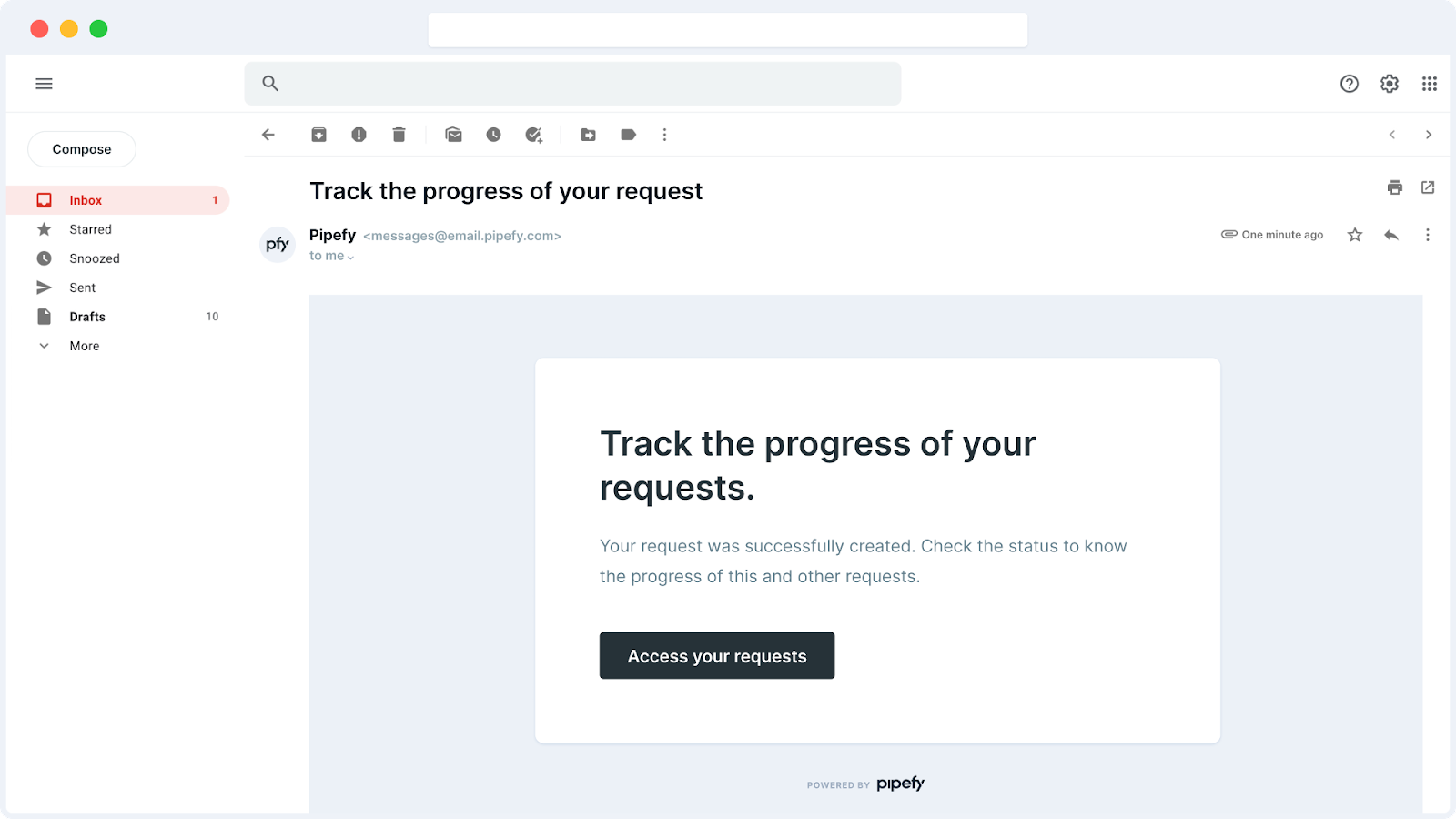
Step 4: Service and escalation
Once the ideal analyst has been designated to handle the ticket, it’s time to resolve the issue. Investigations are conducted, tests are carried out, discussions with other team members — whatever is necessary to ensure FTR (first-time resolution) and customer satisfaction.
Suppose an analyst cannot resolve the issue (whether due to a technical limitation or other restriction). In that case, it’s necessary to escalate the service and contact other people in the support team. The escalation phase can be activated if required, however, it is necessary to ensure that the attendant has the needed data to proceed with the ticket quickly.
Notifications: the whole team working in sync
If a ticket needs to be redirected to someone else on the team, Pipefy’s notifications ensure that the next analyst in line is notified as soon as possible, either in Pipefy or via email. If the ticket card goes to the escalation phase, the new attendant can find all the necessary information directly on the card to continue the resolution.
Deadlines: no information goes unnoticed
In a customer support process, time is precious. That’s why you don’t want to spend more time than needed to resolve customer issues, or lose visibility or control of tickets. With Pipefy’s SLAs features, you can set up automatic alerts for overdue tickets to notify team managers or analysts and prioritize late demands. By doing so, no calls are left behind, and the CSAT score remains high and healthy.
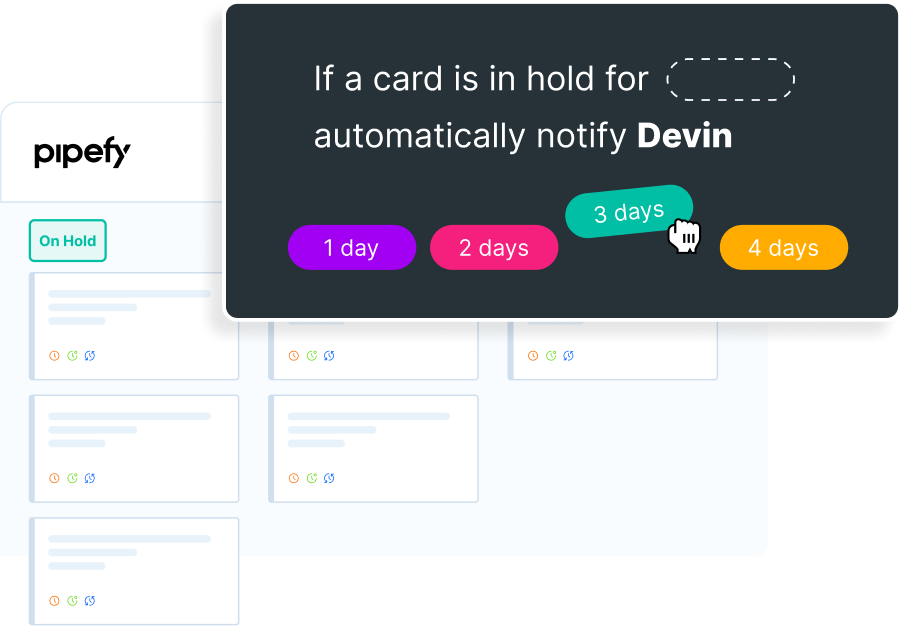
Step 05: Completed
Once the ticket has been resolved, it’s time to celebrate! But first, it is recommended to carry out a traditional customer satisfaction survey, so you can assess the team’s service and identify opportunities for improvement. As tickets are completed, it is up to the team manager to pay attention to the lead time of the process and look for bottlenecks that can be mitigated to facilitate the operation.
Phase emails and forms: collecting NPS
You can use email automations to send messages to collect NPS and receive feedback. This information is collected by a phase form, so it falls directly into the last phase of the process. Remember that it is possible to perform integrations here and send all assessments to other software, such as a Slack channel, for example.
4. Keeping an eye on metrics to improve CSAT
The customer support process must be constantly evaluated and reviewed, as it is continuously being improved. Analysts need to develop customer empathy, and the company must adopt a customer-centric mindset if it truly wants to achieve high levels of satisfaction and an unbeatable customer experience.
Check the key metrics essential for evaluating customer support performance:
1 - FTR: first-time resolution rate
2 - CSAT: customer satisfaction score
3 - Average response time per request
4 - Number of open requests per period
5 - Requests in each phase in the process
6 - Number of services provided by analysts
With Pipefy, it’s easy to access this information with custom reports. Customization allows you to select and build reports with the exact data you want to see, it’s quick and simple to add or remove fields. You can also import Pipefy data into a spreadsheet and share it with people outside the platform.
Dashboards let you create custom charts in just a few clicks. This way you can view process information in graphs, tables, bars, pie charts, and much more. For example:
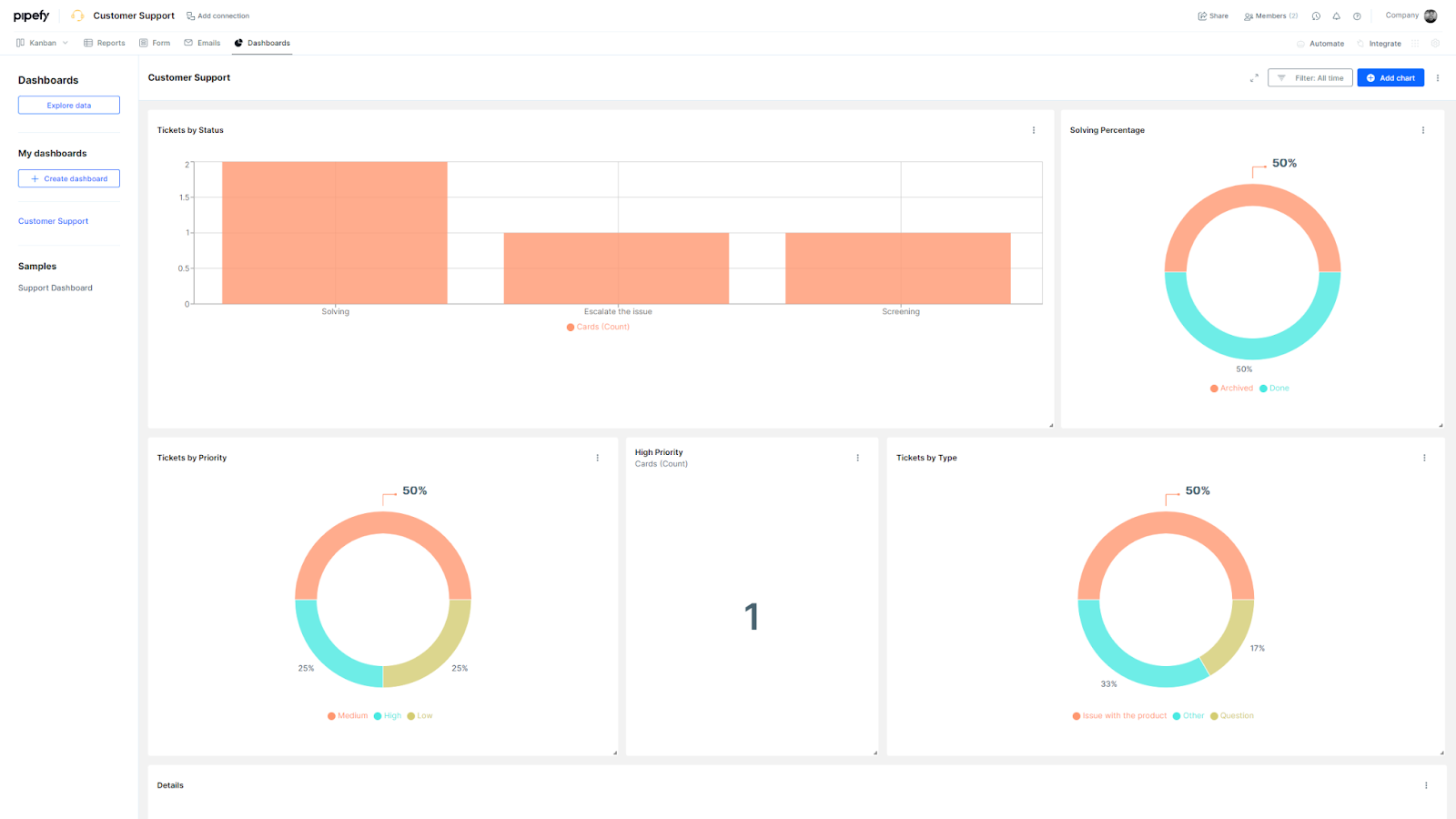
5. Customer support: the secret to leveraging your business
Customer support is fundamental to the growth and maintenance of the image of any company that is expanding its business — and should be prioritized as such. With a dedicated ticket management system, it’s much easier to manage support teams and ensure a positive experience for your customers. Check the main benefits of a customer support process in Pipefy:
Standardization and scalability: The team no longer needs to search multiple sources and sift through information, as standardized and centralized data enters the process. Automations to assign analysts, integrations, and unified communications create a fast flow, with an easy history of the customer journey.
Visibility and control: You now have the ability to monitor team performance and analyze different KPIs with reports and dashboards. Ticket visibility, notifications, and alerts ensure that customers are prioritized and the CSAT grows and remains high.
Customer satisfaction: A transparent and efficient experience for customers, with easy status verification of submitted requests, predictable response times, and measurable SLAs for the team. Automated communication doesn’t let customers in the dark and ensures constant touchpoints.
With Pipefy, you take your customer support process to another level. Get ready to benefit not only your customers, but also create a more engaged, fast, and dynamic team, able to focus on real issues and not waste time with repetitive tasks that don’t add value.
Download the Customer Support template from Pipefy. Download it now!





